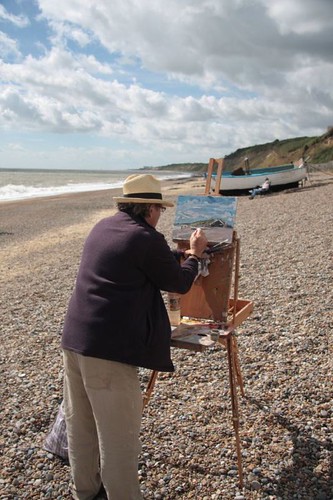In this series I'm looking at how well-chosen digital photos can be used in different areas of the curriculum. In the first one, I looked at the problem of litter.
This one, however, is about a much more pleasant subject: a local artist.
I visited a beach in Suffolk recently, and came across someone painting the landscape. It was a great occasion to have my camera with me!
So who was it? Read on to find out, and to consider some possible curriculum links.
Serendipity
But before that, let me just point out that I could not have hoped for a better illustration of the correctness of my "philosophy": always carry a cam! You never know when you're going to happen upon something that would make a great photo. I would certainly recommend taking one on every class trip. In fact, I would recommend having one camera per teacher, as well as at least one class set that teachers can borrow for field trips and so on.
Extravagant, you say? Oh come on! I was in a supermarket today and it was selling a pretty ok-looking digital camera for less than £30. You could buy a class set (sharing one between two) for less than the price of a single computer system, so what's the problem? But I digress....
The artist
 The artist at workThe artist was (and no doubt still is) Patrick Boswell. He lives in Norfolk, which is in a different County (though not too far away). So what was he doing in Suffolk?
The artist at workThe artist was (and no doubt still is) Patrick Boswell. He lives in Norfolk, which is in a different County (though not too far away). So what was he doing in Suffolk?
Patrick informed me that he was working on a follow-up to his last book. He spent a year painting Norwich street scenes, and you can read about that here.
This time, the theme is beach scenes, and the book should be out next year. I presume it is going to be published by the same company, Frontier Publishing, so look out for that on their website if you like local art and paintings of seashores.
Patrick also has a website, where you can view his paintings in miniature.
A bit of a thrill
OK, perhaps I have lived a sheltered life, but in all my years I have never actually seen an artist in at work, in situ. (Unless, that is, you count a few pavement artists I've come across.)
Also, I'd always assumed that you couldn't paint quickly in oils. I don't know why I thought that, but I did: I've always associated that sort of painting with watercolours.
In any event, it's pretty admirable. If I'd been asked to paint beach scenes, I'd probably take photos and then paint them instead, at my leisure!
Relevance to the curriculum
Schools often arrange visits by local artists and authors. Why not supplement that by photos of the artist at work? Obviously, it would take a bit of arranging, but it could be done.
On the other hand, if you and your class were to come across a local personage, it could be used as a starting point for further research. The obvious focus of the research is the artist himself in this case, and you could get the pupils to do a very nice presentation involving links to the paintings as well as some biographical information about the person concerned.
However, there are other possibilities too:
IT
How could the artist's website be improved, if at all? Could a group of students come up with a specification for selling more paintings over the internet?
Local geography and local history
How has the local area changed over the years, according to how it has been depicted in paintings and drawings, and photographs?
Citizenship and social studies
What's it like working as an artist? Should artists (and musicians and writers) be funded by the State if they're not selling enough to live on? Are there any other people living in the area who are local craftsmen and women?
Media Studies
Are the paintings by people like Patrick realistic? Are they meant to be? Do they depict the scene in a way that is meant to elicit a particular kind of feeling or viewpoint?
English
Use the picture as a starting point for a poem or story.
Conclusion
As I think this brief article has shown, being in the right place at the right time, armed with a digital camera, can open up all sorts of educational opportunities and possibilities. I'd be interested to learn if you can think of any other curriculum applications for this kind photo and the circumstances in which it was taken.
This article was originally published on the old ICT in Education website on 27th August 2008. If you found this article useful, you may also enjoy those found here:
